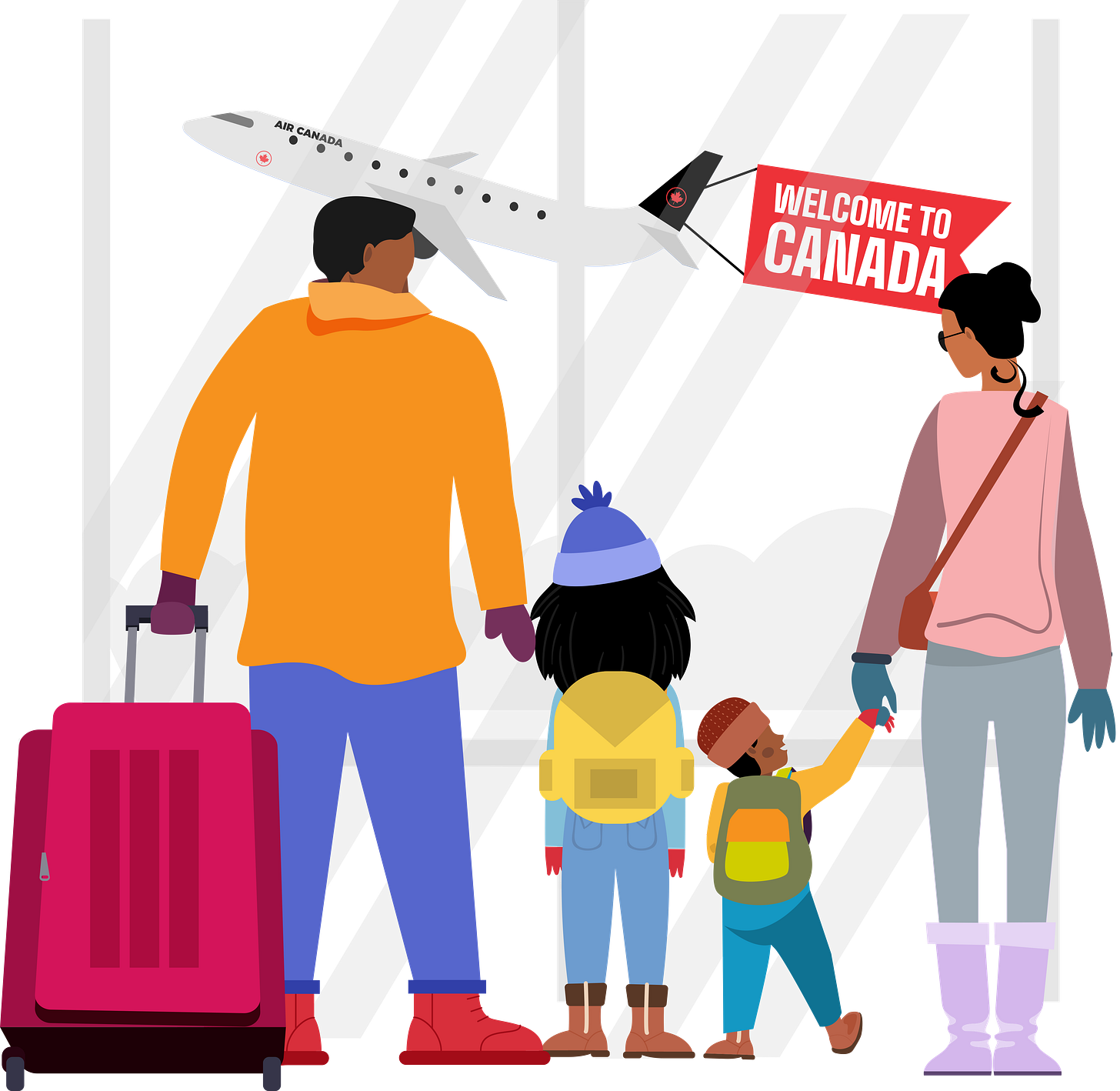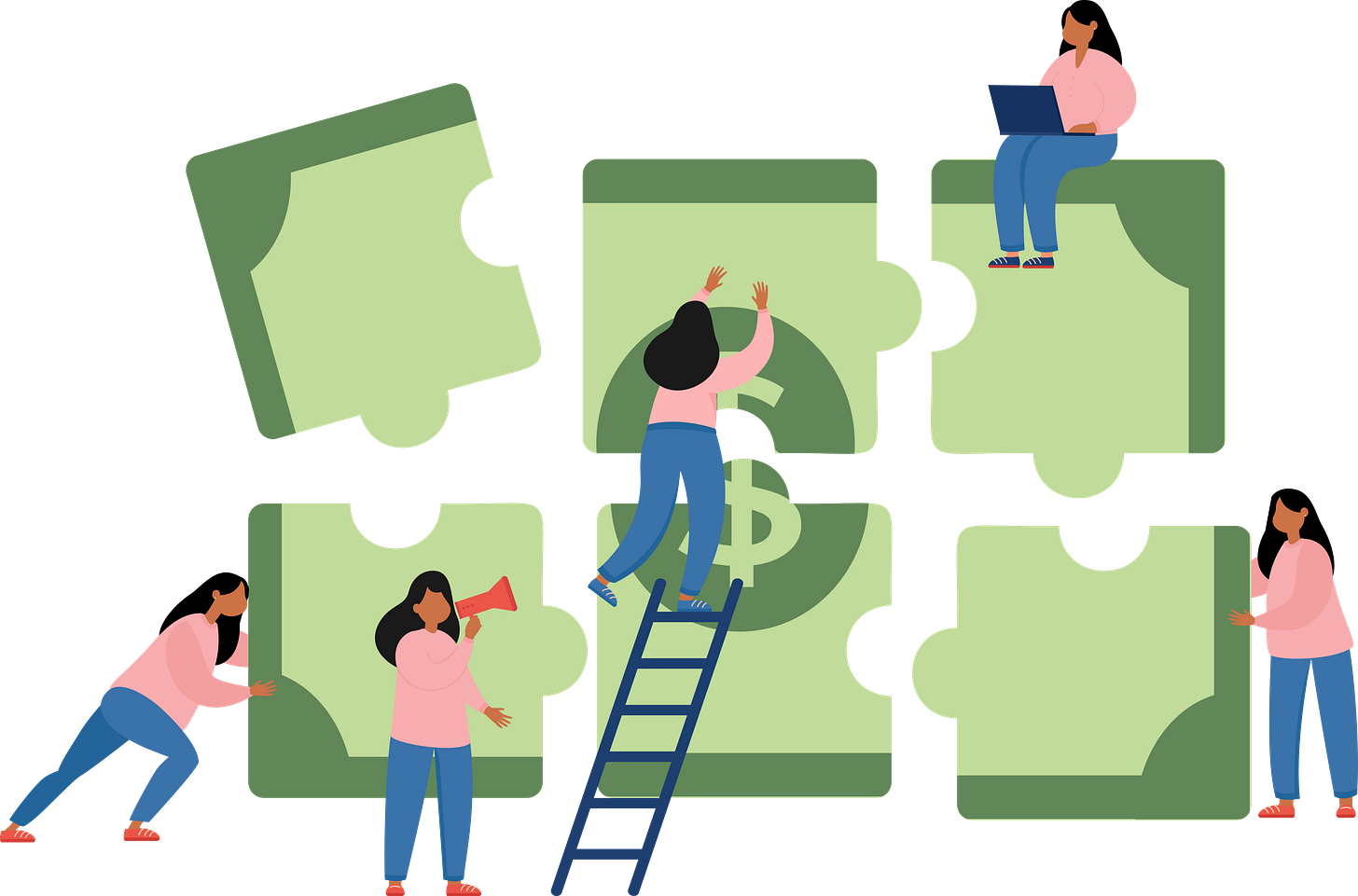A Choose-Your-Own-Adventure Guide to Canada's Financial System for Newcomers
Ready to test your financial might?
Please forward this to ONE friend today and tell them to subscribe here.You’ve just landed in Toronto, Canada with your spouse, two children, suitcases stuffed with clothes, toys, books, plantain chips, and a head full of dreams and hope. It’s 21st January, 2025. The weather looks icy when you look out the massive airport windows but the welcome messages that keep buzzing through have you feeling all warm inside.
The plan? Start a new life. Build a future for your kids. Maybe own a house one day. But one step at a time. You need to figure out how money works in the land of maple syrup and poutine.
The moment you step out of Pearson Airport, the cold hits you so hard that it feels like your lungs might shatter if you take too deep a breath. Your spouse gasps and shuffles closer. The kids look confused, as if thinking, “Daddy, why did we leave sunshine and instant noodles for this cold?”
Your cousin drives up in his brand-new Toyota Highlander. Back in Nigeria, buying this car would have required robbing a small bank. And even though he keeps telling you he’s still paying off the loan, the reality doesn’t quite sink in.
You squeeze your spouse and the kids into the back seat and help your cousin load the bags into the trunk. As your cousin drives away from the airport, he turns to you and says, “Welcome. You’re in survival mode now. Canada isn’t easy.”
He’s not lying. In your first two weeks, you:
Get your SIN (Social Insurance Number)
Open a bank account and start the process of moving your POF (Proof of Funds) into the account
Get your first credit card
Register the kids in school
Apply to over 40 jobs, with each application polished with Grammarly and a silent prayer
As you work through your 45th application, a warehouse in Mississauga calls you. Night shift. $18/hour. You say yes before they even finish the offer. On your first day on the job, Sandra, your manager, goes, “Shrink-wrap the pallets and scan each barcode. Don’t break anything, or you’re paying for it.”
You smile, trying hard to keep up with her accent. But you nod and play it cool. It’s your first job and nothing is going to stop you. Payday arrives. You open your pay stub with excitement, and then let out a silent scream.
Gross Pay: $1,440
Deductions (CPP, EI, Income Tax): $390
Net Pay: $1,050
You squint. “Who is CPP, and why are they taking my money?”
You go home and show your spouse your first paycheck. As you look around the cramped basement room in your cousin’s house, you tear open a pack of plantain chips and rub your tired eyes. Outside, the wind whistles a lonely tune:
Oh Canada…
Your first big decision. Do you:
A. Rent a place now. Because, privacy plus the kids need space.→ Go to Chapter 1A
B. Manage in your cousin's basement for now and start saving money→ Go to Chapter 1B
Chapter 1A: House Hunting in Snow Boots
The landlord’s name is Bob. You found the listing on Facebook Marketplace and the pictures looked okay until you saw the place in real life.
It’s a basement apartment. The walls are beige, the ceiling low, and calling the bathroom miniature would be a compliment. Still, your spouse walks through the place and sighs, “At least I can close the door without asking for permission.”
The kids run around screaming like it’s a palace. You do some quick financial calculations in your head:
Rent is $1,650 per month. Utilities separate.
First + Last month = $3,300
Broker's fee = $500
Mattress from Facebook Marketplace = $180
Boom. Just like that, $4,000 vanishes. You don’t dare look at your account balance. Eight nights later, your spouse is sitting on the mattress (no bed frame yet) and scrolling on their phone. “Can we buy winter jackets for the kids this weekend?” She asks.
You nod slowly. But your brain is yelling, “We need to watch our expenses.”
Time to decide:
A. We’ll budget like accountants going forward.→ Go to Chapter 2A
B. Let’s spend. We’ll make it work somehow.→ Go to Chapter 2B
Chapter 1B: Basement Living. Big Dreams
You decide to swallow your pride and stay in your cousin’s basement a little longer. After all, every dollar you don’t pay in rent is a dollar closer to peace of mind. The place is cramped. The walls are thin. Your cousin’s wife side-eyes you every time you open the fridge.
You pretend not to notice. It’s for a good purpose, you tell yourself. You start tracking your spending on your Notes app:
Contribution to groceries: $300/month
Phone plan: $50/month
Bus pass: $128/month
Helping the family back home: $100/month
You have just enough to breathe a little. You promise yourself you’ll save $500 every month into a proper emergency fund.
You learn about High-Interest Savings Accounts (HISA), and TFSAs. You move half of your POF into a HISA, where your money earns a bit more interest (4% instead of the usual 0.05%) than your regular bank account. You start saving.
After 3 months:
Emergency fund: $1,500
Interest earned on POF: $49.56
Your spouse notices and you proudly tell her: “I know this place is tight. But at least now we have some savings and our POF is earning interest.”
But something stirs in you, a question: “Is this really the vibe in Canada?”
Do you...
A. Play it safe. Let your money grow slowly, no drama. Maybe it’s not exciting. But hey, you sleep well at night.→ Go to Chapter 2A
B. Nudge a slice of your money into a little adventure—a low-risk ETF. Nothing wild, but not boring either. Small gains, yes, but there’s a quiet thrill in watching it move.→ Go to Chapter 2C
Chapter 1C: From Swipe to Sacrifice
You remember how you arrived with your proof of funds. Then, it felt like a cushion. But even though you used it carefully, it went down fast. Faster than anyone warned you.
By month three, the savings are gone. You’ve sent some of it back home to relatives who won’t quit bugging you now that you’re “earning in dollars”, bought painkillers and cold medicine as well as a few jackets, and paid for an extra credential evaluation you didn’t plan for.
So, you start using the credit card. First a little. Then a lot.
Now, you’re forced to swallow your pride. You cancel the auto-payments. You tuck the card in the back of a dusty drawer, behind expired coupons and your SIN letter.
“I will not use this card until things balance”
That night, you sit at the kitchen table with your spouse. You open up the Notes app, and start doing what you once thought was only for accountants: a budget.
You budget like your life depends on it:
Groceries: $280/month
Rent: $1,650 (first priority)
Bus pass: $128
Credit card minimum: $150 (but you start adding more when you can)
Entertainment: Free YouTube
Family back home: Paused (with plenty of guilt)
You even call your phone provider and switch to the cheapest plan. ‘This plan has no data, but home wifi is fine,’ you tell yourself.
Progress:
After 3 months: Paid down $800
After 6 months: Down to $2,200
After 12 months: Debt-free
But the journey wasn’t perfect. You didn’t know you could call the credit card company to negotiate a lower interest rate — nobody told you. You didn’t know about 4Pillars — a nonprofit that helps people restructure debt, negotiate lower payments, or even avoid bankruptcy. You didn’t know because… well, you never asked for help. You didn’t talk to a financial advisor.
So you did it the hard way. Respectable? Yes. Efficient? Not really.
Your spouse sees you reading your budget spreadsheet on a Saturday night and smiles approvingly. You’ve earned that.
Now, you face your next decision:
You’re finally debt-free. The card is unlocked but untouched.
Do you…
A. Start saving into a safe HISA, slowly and surely?→ Go to Chapter 2A
B. Try small investing with ETFs — a little risk, a little reward?→ Go to Chapter 2C
C. Talk to a financial advisor to avoid future mistakes?→ Go to Chapter 2D
Chapter 2A: The Way of the Tortoise
You decide to play it safe with your hard-earned savings. No unnecessary expenses. No rushing into risky business. You know slow and steady wins the race, or at least doesn’t crash and burn. You move all your extra money into a HISA. A 4% per annum interest gain isn’t flashy, but it’s steady. Plus, your money is easily accessible and guaranteed.
After one year:
Salary saved: $2,000
POF saved: $5000
Interest earned: about $280 (tax-free)
It’s not enough to buy a new car or take the family on vacation, but it’s enough to cover unexpected bills or a few jollof rice dinners without stress. Your spouse smiles and says, “Well done, good move.”
Meanwhile, you’ve learned that keeping an emergency fund helps you avoid borrowing from friends or using credit cards when things get tight. But even as you enjoy your jollof (with extra plantain, of course), a little voice pipes up:
“This $280 is cool, but can’t I earn more?”
You remember your colleague. The one always talking about ETFs and RRSPs like it’s magic. At first it sounded like something only finance gurus could comprehend, but now? You’re intrigued. Your money has rested. Maybe it’s time to hustle.
What’s your next move?
A. Take a bold step. Invest part of your savings in ETFs or RRSPs. Small risk, bigger potential reward.→ Go to Chapter 3A
B. Call for backup. Speak to a financial advisor who can break things down before you confuse ETF with BFF.→ Go to Chapter 2D
Chapter 2B: The Risks of Credit and Debt
You think, “We have the proof of funds. I have to spend on my family now. We’ll make the money back.” At first, it feels smooth and easy. You use the savings to buy groceries. You pay for the monthly bus pass. You get everyone some nice-looking warm jackets.
But soon, the proof of funds starts running low. You didn’t expect everything to add up so fast. Rent, deposits, school supplies, prescriptions, the needs go on and on.
You hold off using the credit card for as long as you can. But when the fridge is near empty and payday is still two weeks away, you give in. Swipe. Then swipe again.
Then bills start piling up. You start making only the minimum payments. Interest and fees grow. Your credit score drops.
Your spouse sighs, “How are we going to survive this?” Time to decide.
Do you:
A. Start budgeting to pay off debt faster.→ Go to Chapter 1C
B. Keep swiping, hoping you get a better job and things improve.→ Go to Chapter 3B
C. Talk to a financial advisor.→ Go to Chapter 2D
Chapter 2C: Flying Solo in the Investment World
You invest part of your savings in a few popular ETFs, mostly Canadian banks and energy stocks. No advisor, just YouTube and that “know-it-all” in your office. After one year:
Growth: ~5%
Missed diversification
Higher-than-necessary fees (*MERs)
Missed consistent contributions (no **dollar-cost averaging)You remember the financial advisor you met at a free workshop. Maybe they could help you plan better.
Do you say:
A. “Let me keep trying on my own. I’ve made it this far, I’ll figure the rest out.”→ Continue to figure it out on your own in Chapter 4B
B. “It’s time to talk to someone who knows what they’re doing.”→ Schedule a proper sit-down in Chapter 2D
*MERs (Management Expense Ratios): This is a yearly fee the fund manager takes to run the investment. It quietly eats into your returns if you’re not careful.
**Dollar-cost averaging: Instead of putting all your money in at once, you invest small amounts regularly (like every payday). This spreads out the risk — you buy some shares when prices are high, some when prices are low, This reduces the probability that you will make a huge loss.
Chapter 2D: Meeting the Advisor
You finally meet a financial advisor. It’s not as intimidating as you thought. Over coffee, you learn the things no one taught you before:
Diversify accounts (TFSA, RRSP, RESP) and investments (stocks, bonds, ETFs, GICs, HISA)
Use RRSP to reduce taxes
Aim for 3–6 months in emergency savings
Use RESP for kids (get the CESG grant)
Protecting family through insurance is important
Avoid lifestyle inflation
You nod, take notes, and go home with a plan. After one year:
Family protected via insurance- Done
Emergency fund — Done
TFSA + RRSP — Done
RESP started for the kids — Done
Lower tax bill — Done
That Friday night, you and your partner sit on the couch, laptop closed, the spreadsheet finished. You share a bottle of wine and smile at each other. Not because you’ve arrived, but because you sense you’ve just started.
Next decision:
A. Stick with the plan and keep learning.→ Go to Chapter 4A
B. Go it alone. You’ve learned enough.→ Go to Chapter 4B
Chapter 3A: Beginning Your Investment Journey
You begin investing with new confidence. With the help of ChatGPT, YouTube and the know-it-all guy in your office, you build a diversified portfolio. No crypto bets, just good ol’ slow and steady compound interest.
Your TFSA holds index ETFs. Your RRSP contributions are automatic. You even open an RESP for the kids. You’re saving. You’re building. You’re proud of yourself.
To make things even better, you’re killing it at work and so, you receive a surprise: a $5,000 bonus from work. Unexpected, sweet, and tempting.
You decide to use this money as part payment for a new car, but not now, maybe in another 8 months, perfect timing for your spouse’s birthday. In the meantime, what do you do with the money?
Do you?
A. Save the $5K in your HISA — safety first.→ Go to Chapter 3AA
B. Invest in some ETFs- cautious risk, smart growth.→ Go to Chapter 3AAA
C. Speak to a financial advisor.→ Go to Chapter 2D
Chapter 3AA: The Almost Perfect Plan — Safe Money, Missed Moves
You make a smart move. You look at your $5,000, look at your spouse, look at the car you currently drive — the one that overheats even in winter — and say, “We will need this money soon.”
So, you park the money in your High-Interest Savings Account (HISA). No noise, no stress. Every month, it quietly grows. Not much, but enough to whisper, “I’m still here.”
After a year? Boom. You earn about $80 in interest — tax-free. Your money is safe, accessible, and sitting pretty, just waiting for that new car moment. Even your spouse nods in approval.
Then, during a random conversation with a financial advisor you meet at a party, you learn that there are other options out there that could’ve given your money a little more muscle, especially since you have a clear timeline.
But it’s all good. Your money is intact. You’ve just gotten a promotion at work, so you have more money to play with.
You can still buy that car. But as you're handing over the cheque at the dealership, you sigh and mutter, “If I had asked an advisor, I would have been able to buy a car with alloy rims or a pre-heated steering wheel.”
Now, it’s time to make your next money move. Choose one. Your money is waiting…
A. Speak to a financial advisor.→ Go to Chapter 2D
B. I’ve learnt enough, I can do this by myself.→ Go to chapter 4B
Chapter 3AAA: The Brave but Bumpy Investor
The $5,000 bonus is cool, but since you don’t need it immediately, you decide to let your money work a little.
So you pull $2,000 out of it and toss it into a couple of ETFs — one tracking the whole market, another looking fancy with “dividends” in the name. You don’t fully understand it, but the guy on YouTube says it’s “passive income.” And it sounds like the kind of magic you need.
At first? Beautiful. Your account goes up $37 in two weeks. You’re already calculating car upgrades. “Leather seats, moonroof, and tinted windows, here we come.”
But life has other plans. Six months in, the market does a backflip and lands face-first. Headlines scream things like “Correction!” and “Volatility!” Meanwhile, your ETF balance is correcting your dreams downwards.
You watch $2,000 become $1,720. You panic. “What is this? This is no longer market volatility. It is a spiritual attack.” Since you can’t risk losing all the money, you pull out right in the middle of the market downturn. No time to wait for a rebound.
Your spouse asks about the car fund. You mutter something about, “The car will come. Just not this quarter.”
Moral of the story? ETFs are powerful, but they’re a long game. Not for short-term money you can’t afford to lose. You take the risk, you learn the lesson, and thankfully, you still have most of the money.
But next time? Before investing, you ask yourself two things:
Do I need this money soon?
Will I cry if the market crashes a little?
If the answer to both is “yes,” then maybe, you wait. Just maybe, investing isn’t the choice for you.
Now you’ve learnt your lesson, do you:
A. Speak to a financial advisor.→ Go to Chapter 2D
B. I’ve learnt enough, I can do this by myself.→ Go to chapter 4B
Chapter 3B: Full Debt Mode
Your credit card is maxed out. Balance: $4,980. Rent is due in 3 days. CRA just sent you a letter: “Outstanding tax balance: $1,100.” You’ve stopped checking emails. Your phone ringtone gives you heart palpitations. Even your kids notice that all is not right.
“Daddy, are you sad?” You smile, but the truth is you’re tired.
You remember how it started. Just a few taps on your card here and there. A few times you dipped into your savings to help your family. You thought you could catch up. You didn’t.
A friend at work tells you about a service called 4Pillars — they help Canadians in deep debt negotiate with creditors, reduce what they owe, and build back their credit. You listen politely but brush it off.
“ I can’t afford to pay anybody for help right now.”
But deep down you know you can’t afford not to.
Do you:
A. Go to 4Pillars.→ Go to Chapter 4C
B. I don’t want my business out there.→ Go to chapter 4D
Chapter 4A: The Long Game — Growth & Stability
It’s been a few years since those cold nights in your cousin’s basement. Looking back, the patience, sacrifice, and wise financial choices are finally paying off.
You now:
Have a $10,000 emergency fund
Max out your TFSA annually
Contribute to your RRSP and get a decent tax refund
Got $1,000+ in CESG free from the government for the kids' RESP
And your credit score? 810
Your spouse says, “You remember when we used to worry about going to the fridge in your cousin’s kitchen? Look how far we’ve come.” You nod. You still have a long way to go.
But for now, you win.
The End
Chapter 4B: DIY Investing — The Riskier Route
You skip the advisor. Afterall, most of them don’t know what they’re doing and the ones who do are after your money. You read all you can and learn a lot more and become even more financially educated.
You move your TFSA money into individual stocks and crypto ETFs. Some hits, some misses. In one year, you make $2,000. In another year, you lose $1,500. This year, it’s... meh.
You open an RRSP but don't track your contributions. CRA penalizes you for over-contributing. You forget about RESP. By the time someone mentions the $500/year CESG grant, your child is almost 8. You lose years of free money.
You still have savings. Your TFSA sits at $7,000. Not bad. But it could’ve been $11,000 with less stress and better planning. Your spouse says, "At least we’re not in debt”. You nod. Small wins. Slight regrets.. You can’t win them all.
You survive, but you don’t thrive.
Oh Canada!
The End
Chapter 4C: Burnt, But Not Burnt Out
The call with 4Pillars is quiet. No judgment. Just facts.
They look at your debt, income, and credit score. They explain that they can help reduce what you owe and build a real plan with the help of your financial advisor to get back on your feet.
You sign up for a structured repayment plan. Monthly payment: $250, no more interest. Creditors stop calling. You breathe. Over the next few years:
You stick to the plan.
You track your spending.
You file your taxes on time.
You attend their credit rebuilding workshop.
You open a secured credit card and build a new credit history, brick by brick.
By year three, you’re debt-free. Your credit score isn’t perfect, but it’s alive. 650 and rising. You’re not rich. You’re not flashy. But you’re no longer afraid to check your email. Or answer your phone. Or plan for tomorrow.
Your spouse notices the shift.“Even though we passed through fire, we’re still alive” You smile. Scarred, but still standing. You didn’t win every battle. But you didn’t lose the war.
You made it.
The End.
Chapter 4D – Alone in the Storm
You decide to push through without help. “I got myself into this mess, I’ll get myself out,” you mutter.
You juggle bills, ignore calls, and cut corners wherever you can. But the numbers don’t shrink—they grow. Interest stacks higher, creditors grow louder, and stress eats away at your health. You miss rent. Then your car payment. Then… something breaks inside.
Months later, you look back at the letter from CRA, the friend’s advice, the advisor’s number you never called. Regret stings. You realize it wasn’t weakness to ask for help—it was wisdom. But by the time you accept this, the damage is done.
The End.
If you’d like to support this work, consider buying me a coffee.











I love that I ended up at Chapter 4A 🤭 I’m currently scheduled to speak with a financial advisor next month… still skeptical but very open to listening and learning
Good read very apt picture of the struggles of settling in financiallt